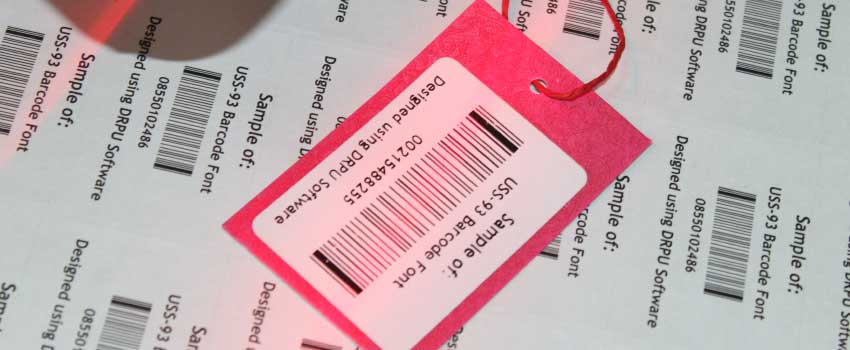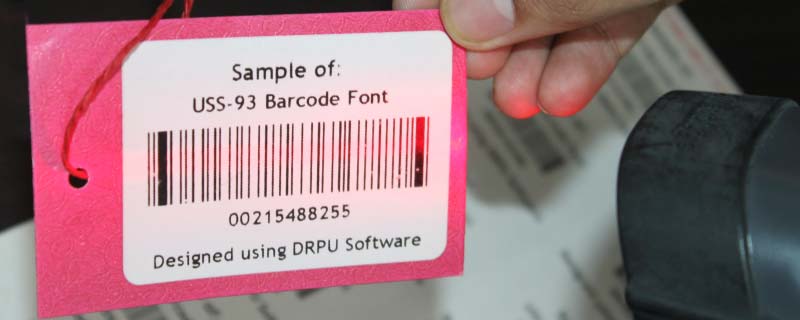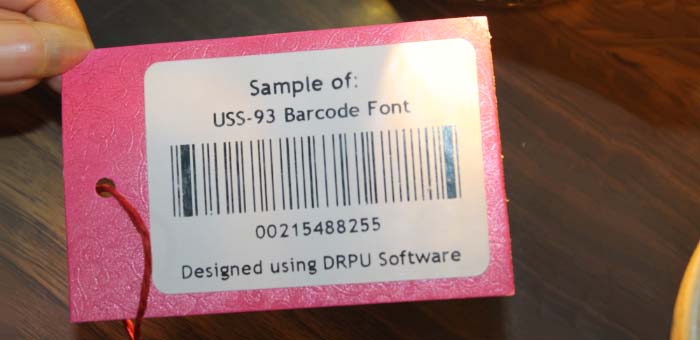Introduction of USS-93 Barcode
USS-93 (Uniform Symbology Specification 93) is a type of two-dimensional barcode used for encoding information in a wide variety of applications, such as inventory management, shipping, and logistics. It is similar to Code 39 and Code 128 barcodes, but is more compact and can encode a wider range of characters.
-
USS-93 barcodes consist of a series of bars and spaces arranged in a rectangular pattern. The barcode can encode up to 47 characters, including letters, numbers, and symbols. The barcode also includes a start character, stop character, and a checksum digit to help ensure accuracy during scanning.
-
USS-93 barcodes are designed to be read by scanners or cameras that are equipped with specialized software. The software is able to interpret the barcode and extract the encoded information, which can then be used for a variety of purposes.
-
One of the key advantages of USS-93 barcodes is their high density. Because the bars and spaces are arranged in a rectangular pattern, USS-93 barcodes can be printed at a high resolution and still be readable by scanners. This makes them ideal for applications where space is limited, such as on small inventory tags or shipping labels.
-
Another advantage of USS-93 barcodes is their versatility. They can encode a wide range of characters, including letters, numbers, and symbols. This makes them useful in a variety of applications, from tracking inventory to managing shipping and logistics.
-
USS-93 barcodes can be printed using a variety of printing methods, including inkjet, laser, and thermal transfer. They can be printed on a wide range of materials, including paper, plastic, and metal. Because they are so versatile, USS-93 barcodes are widely used in many industries, including retail, manufacturing, and logistics.
Conclusion: Overall, USS-93 barcodes are a useful and versatile tool for encoding and tracking information in a wide variety of applications. Their high density and versatility make them ideal for applications where space is limited and a wide range of characters needs to be encoded.
Applications of USS-93 Barcode
USS-93 is a widely used barcode symbology that has numerous applications across various industries. Some of the key applications of USS-93 barcode are:
-
Inventory Management:
USS-93 barcode is commonly used for inventory management in various industries, including retail, healthcare, and manufacturing. The barcode can be used to track inventory levels, monitor stock movements, and automate reordering processes. This helps to ensure that inventory is always at an optimal level, which can help to reduce costs and improve efficiency.
-
Shipping and Logistics:
USS-93 barcode is also used in shipping and logistics to track packages and shipments. The barcode can be used to identify packages, track their movement, and automate sorting and routing processes. This helps to ensure that packages are delivered on time and to the correct destination, which can improve customer satisfaction and reduce costs.
-
Document Management:
USS-93 barcode is used in document management to track and manage documents. The barcode can be used to identify documents, track their movement, and automate filing and retrieval processes. This helps to ensure that documents are organized and easily accessible, which can improve efficiency and reduce costs.
-
Healthcare:
USS-93 barcode is widely used in healthcare for patient identification and medication management. The barcode can be used to identify patients, track their medical history, and ensure that the correct medication is administered to the correct patient. This helps to reduce medication errors and improve patient safety.
-
Asset Tracking:
USS-93 barcode is used in asset tracking to track and manage assets such as equipment, vehicles, and tools. The barcode can be used to identify assets, track their location, and automate maintenance. This helps to ensure that assets are properly maintained and utilized, which can improve efficiency and reduce costs.
-
Manufacturing:
USS-93 barcode is used in manufacturing for product identification, tracking, and quality control. The barcode can be used to identify products, track their movement through the manufacturing process, and ensure that quality control processes are followed. This helps to improve efficiency, reduce costs, and ensure product quality.
-
Retail:
USS-93 barcode is widely used in retail for product identification and inventory management. The barcode can be used to identify products, track inventory levels, and automate checkout processes. This helps to improve customer service, reduce costs, and improve inventory management.
Overall, USS-93 barcode is a versatile barcode symbology that has numerous applications across various industries. Its ability to store a large amount of data in a compact format, and its ease of use and reliability, make it a popular choice for businesses looking to improve efficiency and reduce costs.
Structure of a USS-93 Barcode
The structure of a USS-93 barcode consists of a series of bars and spaces arranged in a rectangular pattern. Each bar or space represents a binary digit, or bit, which can be either a zero or a one. The pattern of bars and spaces encodes a series of characters, which can include letters, numbers, and symbols.

- The USS-93 barcode includes a start character, a stop character, and a checksum digit, which are used to help ensure accuracy during scanning. The start character and stop character are typically represented by an asterisk symbol (*), while the checksum digit is a calculated value that helps detect errors in the barcode.
- In addition to the start character, stop character, and checksum digit, the USS-93 barcode can also include a variety of other special characters, such as shift characters and control characters. These characters are used to change the interpretation of the data encoded in the barcode, allowing for a wider range of characters to be encoded.
- The basic structure of a USS-93 barcode includes two types of bars and spaces: wide bars and narrow bars. Wide bars are twice as wide as narrow bars, and are typically used to encode the start and stop characters. Narrow bars are used to encode the data characters.
- The barcode is divided into three parts: the left guard pattern, the data characters, and the right guard pattern. The left guard pattern is a fixed pattern of bars and spaces that indicates the beginning of the barcode. The data characters represent the information that is encoded in the barcode. The right guard pattern is a fixed pattern of bars and spaces that indicates the end of the barcode.
- The data characters are encoded using a series of five bars and spaces, which represent five bits of information. Each character is represented by a series of nine bars and spaces, which encode nine bits of information. The characters are separated by a single narrow space.
- The USS-93 barcode can encode up to 47 characters, including letters, numbers, and symbols. It is a variable length barcode, which means that the number of characters that can be encoded in the barcode is not fixed. This makes it useful for encoding a wide range of information, from product codes to shipping information.
Conclusion: The structure of a USS-93 barcode is relatively simple, consisting of a series of bars and spaces arranged in a rectangular pattern. The use of start and stop characters, as well as a checksum digit, helps ensure accuracy during scanning, while the use of wide and narrow bars allows for the encoding of a wide range of characters.
Difference Between USS-93 Barcode and other Barcode Types
The USS-93 barcode, also known as Code 93, is a type of 1D linear barcode similar to Code 39, but with a higher data density and greater security. Here are some ways in which USS-93 differs from other barcode types:
- 01
Data Density:
USS-93 can encode up to 47 characters per barcode, which is higher than Code 39, making it ideal for situations where more data needs to be stored in a smaller space.
- 02
Security:
USS-93 includes two check digits that are used to verify the accuracy of the encoded data, making it more secure than other barcode types that don't include check digits.
- 03
Character Set:
USS-93 can encode uppercase letters, numbers, and a few special characters, including "-", ".", "$", "/", "+", and "%". Other barcode types, such as Code 128, can encode a wider range of characters.
- 04
Printing:
USS-93 can be printed using a variety of printing methods, including thermal transfer, direct thermal, and dot matrix. However, the barcode must be printed at a high resolution to ensure accurate scanning.
- 05
Application:
USS-93 is commonly used in applications that require high-density, secure barcoding, such as in the automotive and electronics industries.
- 06
Compatibility:
USS-93 is compatible with most barcode scanning equipment, making it easy to integrate into existing systems.
Conclusion: USS-93 offers a high level of data density and security, making it ideal for situations where large amounts of data need to be stored in a small space while ensuring the accuracy and integrity of the data.
Minimum and Maximum Length of a USS-93 Barcode
The minimum and maximum length of a USS-93 barcode is determined by the number of characters that can be encoded in the barcode. The number of characters that can be encoded in a USS-93 barcode depends on the width of the barcode and the encoding scheme used.
-
The USS-93 barcode uses a variable length encoding scheme, which means that the number of characters that can be encoded depends on the width of the barcode. The wider the barcode, the more characters can be encoded.
-
The minimum length of a USS-93 barcode is 2 characters, which includes a start character and a stop character. The start and stop characters are represented by the characters '' and '', respectively. These characters are used to indicate the beginning and end of the barcode.
-
The maximum length of a USS-93 barcode depends on the width of the barcode. For a standard barcode with a width of 1 inch (25.4 mm), the maximum length is 31 characters. For a wider barcode with a width of 2 inches (50.8 mm), the maximum length is 63 characters.
-
However, it is important to note that the maximum length of a USS-93 barcode may vary depending on the specific application or system in which the barcode is being used. In some cases, the maximum length may be limited by the available space on the label or the capacity of the barcode scanning equipment.
-
In general, the length of a USS-93 barcode should be carefully determined based on the amount of data that needs to be encoded and the size of the label or packaging on which the barcode will be printed. This will help ensure that the barcode can be accurately scanned and read by barcode scanning equipment.
Download and Install
Barcode Label Maker SoftwareCharacters That Can be Encoded in a USS-93 Barcode
The USS-93 barcode uses a set of 47 different characters to encode data, including letters, numbers, and special characters. These characters include uppercase letters A-Z, lowercase letters a-z, numbers 0-9, and several special characters, as listed below:
-
Space
Hyphen
Period
Dollar sign ($)
Slash (/)
Plus sign (+)
Percent sign (%)
-
Ampersand (&)
Asterisk (*)
Left parenthesis (
Right parenthesis )
Comma
Colon
Semi-colon
-
Less than sign
Equals sign (=)
Greater than sign (>)
Question mark (?)
At sign (@)
Left square bracket [
Backslash ()
-
Right square bracket ]
Circumflex (^)
Underscore (_)
Grave accent (`)
Left curly brace {
Vertical bar (|)
Right curly brace }
These characters can be combined to create alphanumeric strings of varying lengths and content, depending on the specific application and data being encoded. It is important to note that some of these characters have special meanings or uses within certain contexts, such as the slash (/) used to separate different fields in a data string. Therefore, it is important to carefully consider the specific requirements and limitations of the intended use of the USS-93 barcode when selecting and encoding data.
USS-93 Barcode Read and Decoded
The USS-93 barcode is read and decoded using a barcode scanner or reader, which uses a light source to illuminate the barcode and a sensor to detect the reflected light. As the barcode is scanned, the sensor detects the pattern of light and dark bars and spaces, and converts this information into a digital signal that can be interpreted by a computer or other device.

To decode a USS-93 barcode, the scanner or reader must be able to distinguish between the different widths and spacings of the bars and spaces, and map these patterns to the corresponding characters or data. This process typically involves several steps, including:
- 01 Scanning the
Barcode:
The first step in decoding a USS-93 barcode is to scan it using a barcode scanner or reader. This can be done using a handheld scanner, a stationary scanner, or a mobile device with a built-in camera and barcode scanning software.
- 02 Reading the Bar
and Space Patterns:
As the barcode is scanned, the sensor in the scanner or reader detects the pattern of light and dark bars and spaces, and converts this information into a digital signal. The scanner then analyzes the pattern of bars and spaces to determine the character or data encoded in the barcode.
- 03 Decoding the
Data:
Once the scanner has identified the pattern of bars and spaces, it must decode this information to determine the corresponding characters or data. This typically involves mapping the barcode pattern to a lookup table or algorithm that maps specific patterns to specific characters or data values.
- 04 Verifying the
Data:
After the data has been decoded, it is typically verified to ensure that it is accurate and complete. This may involve checking the data against a database or other source of information, or performing additional checks to ensure that the data is valid and usable.
Overall, the process of reading and decoding a USS-93 barcode is relatively straightforward, and can be done quickly and accurately using a barcode scanner or reader. However, it is important to ensure that the scanner is properly calibrated and configured to read the specific type of barcode being used, and that the barcode is printed or displayed clearly and accurately to ensure accurate and reliable decoding.
